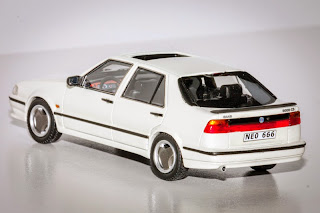The Saab 9000 is a large executive car that was produced by the Swedish company Saab from 1984 to 1998. Representing the company's foray into the executive car scene, the 9000 remained in production until it was replaced by the Saab 9-5 in late 1999.
Saab designed the 9000 as part of the Type Four platform in conjunction with the Italian automaker Fiat Automobiles. Fiat retailed similar derivative versions as the more basic Fiat Croma, the luxury-themed Lancia Thema, and the sports-oriented Alfa Romeo 164. Unlike the 164, which shares only the chassis, the Croma and Thema are outwardly similar to the 9000. As such, much of the bodywork appeared interchangeable between the 9000, Croma and Thema; for example, the doors. However, because Saab fitted heavier side impact protection they will not fit. Only seven different parts are actually interchangeable. The 9000's body was designed by Giorgetto Giugiaro and Saab designer Björn Envall.
Despite being shorter overall than the 900, the 9000 had a longer wheelbase and greater interior space, and was the first Saab vehicle imported to the United States to be classed as a "large car" by the EPA.
Saab presented an updated version of the liftback body variant in 1991 for the 1992 model year with the "CS". Featuring a lowered front fascia with new headlights, grille and a substantially redesigned rear-end. Both the "CS" and better-equipped "CSE" editions were available with a 2.3-litre inline-four—either turbocharged or in normally aspirated tune. The "CS Turbo" was equipped with a low-pressure turbocharger setup producing 127 kW (170 hp), while the "CSE Turbo" sported a full-pressure turbocharger with 149 kW (200 hp). Both systems used the same Garett T25 turbocharger with a base boost pressure of .4 bar (6 psi) but the full pressure turbo is equipped with a boost control valve that is manipulated by the ECU. This allows the boost pressure to be increased as the ECU sees fit. Maximum stock boost on a full pressure turbo varies from .7 to 1.02 bar (10 to 15 psi) depending on the year and transmission.
In European markets, a smaller 2.0-litre engine was offered in normally aspirated form 97 kW (130 hp), light-pressure turbo 112 kW (150 hp) or full-pressure turbo 130 kW (175 hp). The "CDE" model was offered initially with only the 149 kW (200 hp) turbocharged engine, and later the 3.0-litre V6.
In 1995, a 3.0-litre B308 V6 engine with 157 kW (210 hp) was introduced as standard for the "CDE" sedan and optional for the "CSE" liftback. The V6 was discontinued in the United States after one year along with the "CDE" model, but continued on in Europe until 1997. In some European markets, a high-spec "CDE Griffin" model was offered with numerous luxury appointments. After the 1995 model year, naturally aspirated four-cylinder engines were discontinued in the United States.
+(01).jpg)
+(02).jpg)
+(03).jpg)
+(04).jpg)
+(05).jpg)
+(06).jpg)
+(07).jpg)
+(08).jpg)
+(09).jpg)
+(10).jpg)
Technical data:
- engine: V6
- capacity: 3000 cc
- horsepower: 210 HP
- gearbox: 5+1
- top speed: 220 km/h

3 komentarze:
Great Blogsite you have here, and awesome collection you have! :-)
Model pięknie się prezentuje. Wysoki poziom.
Thanks Mike, appreciate that.
W realu jest jeszcze lepszy :)
Prześlij komentarz